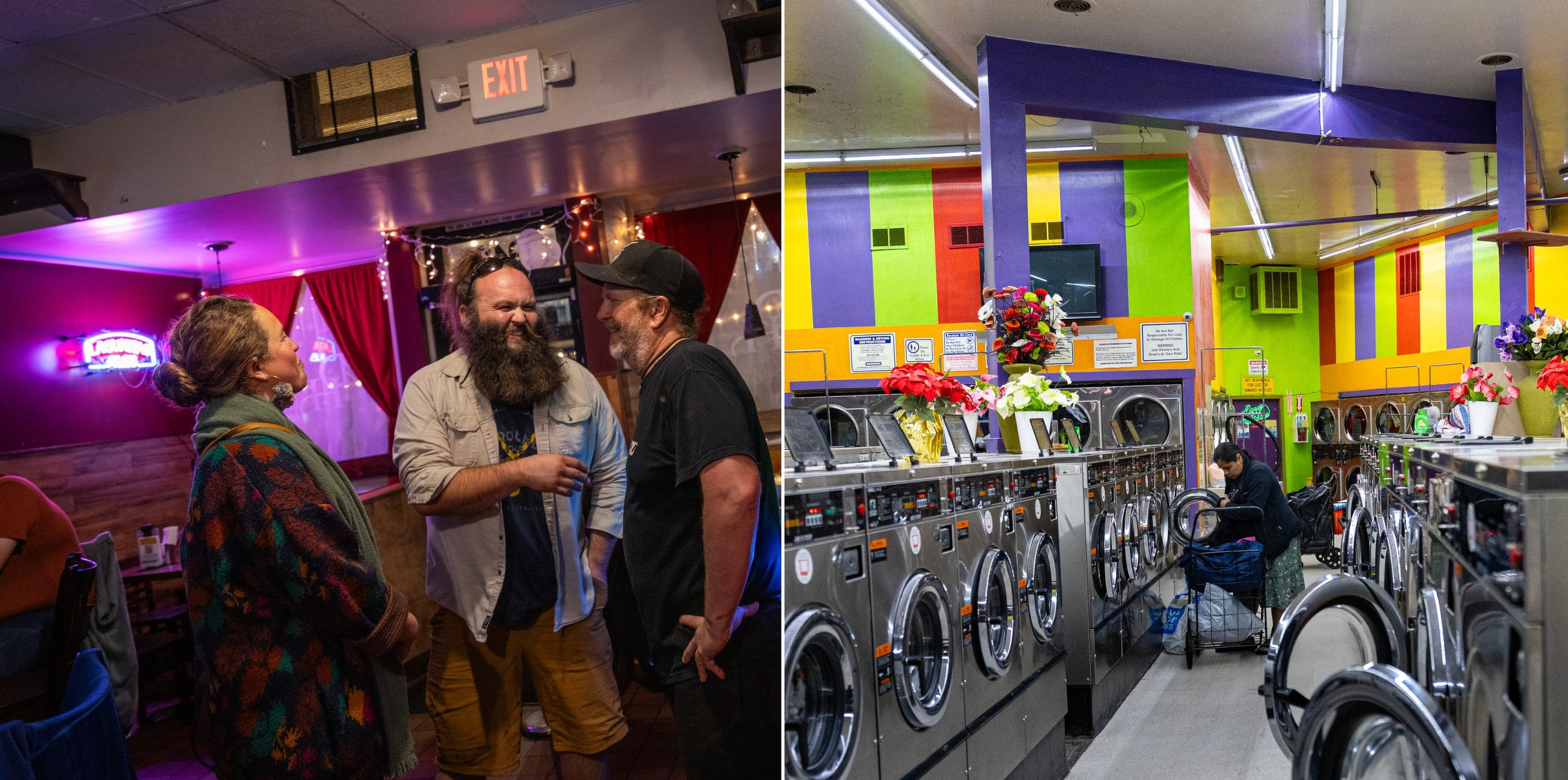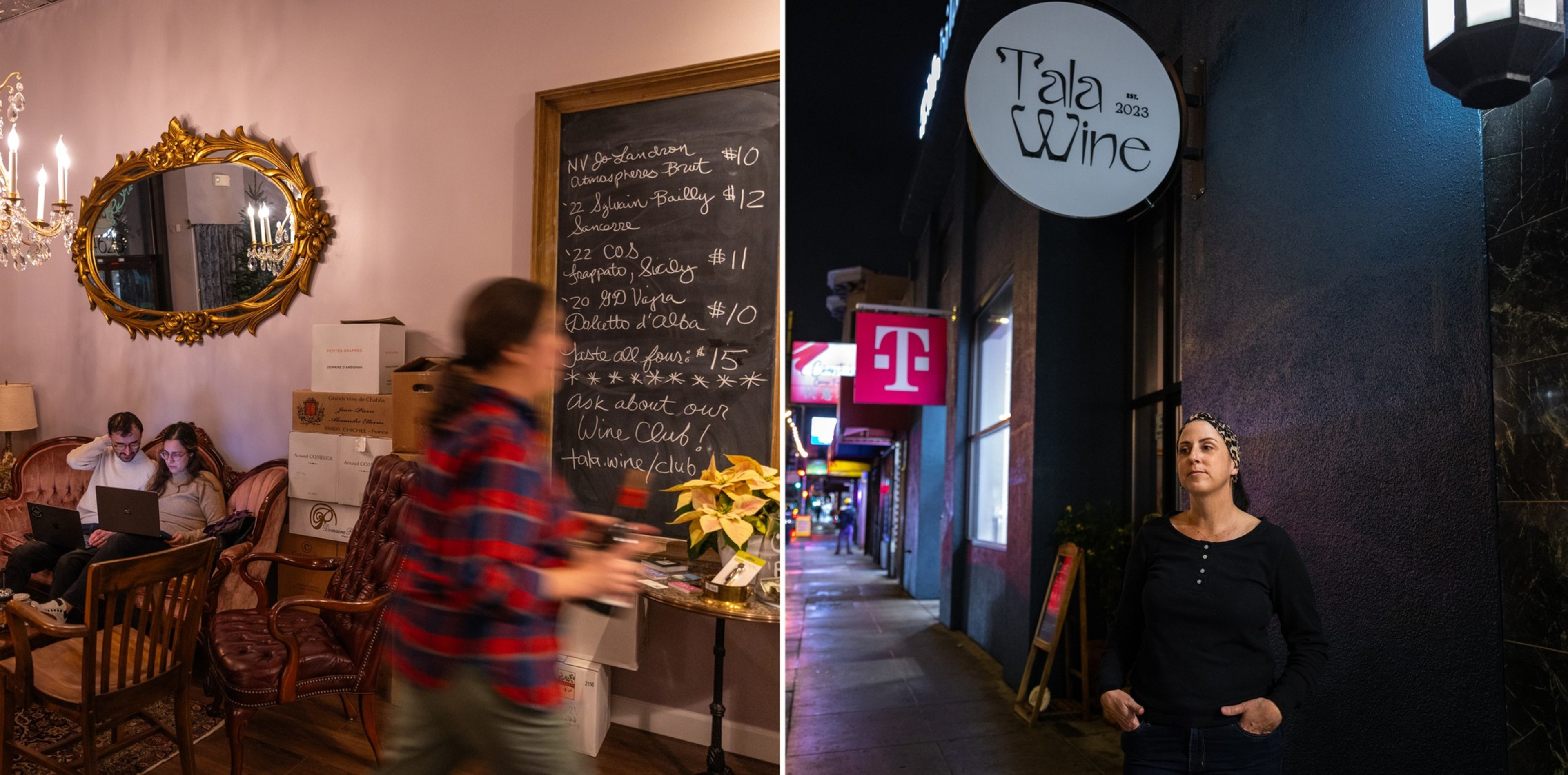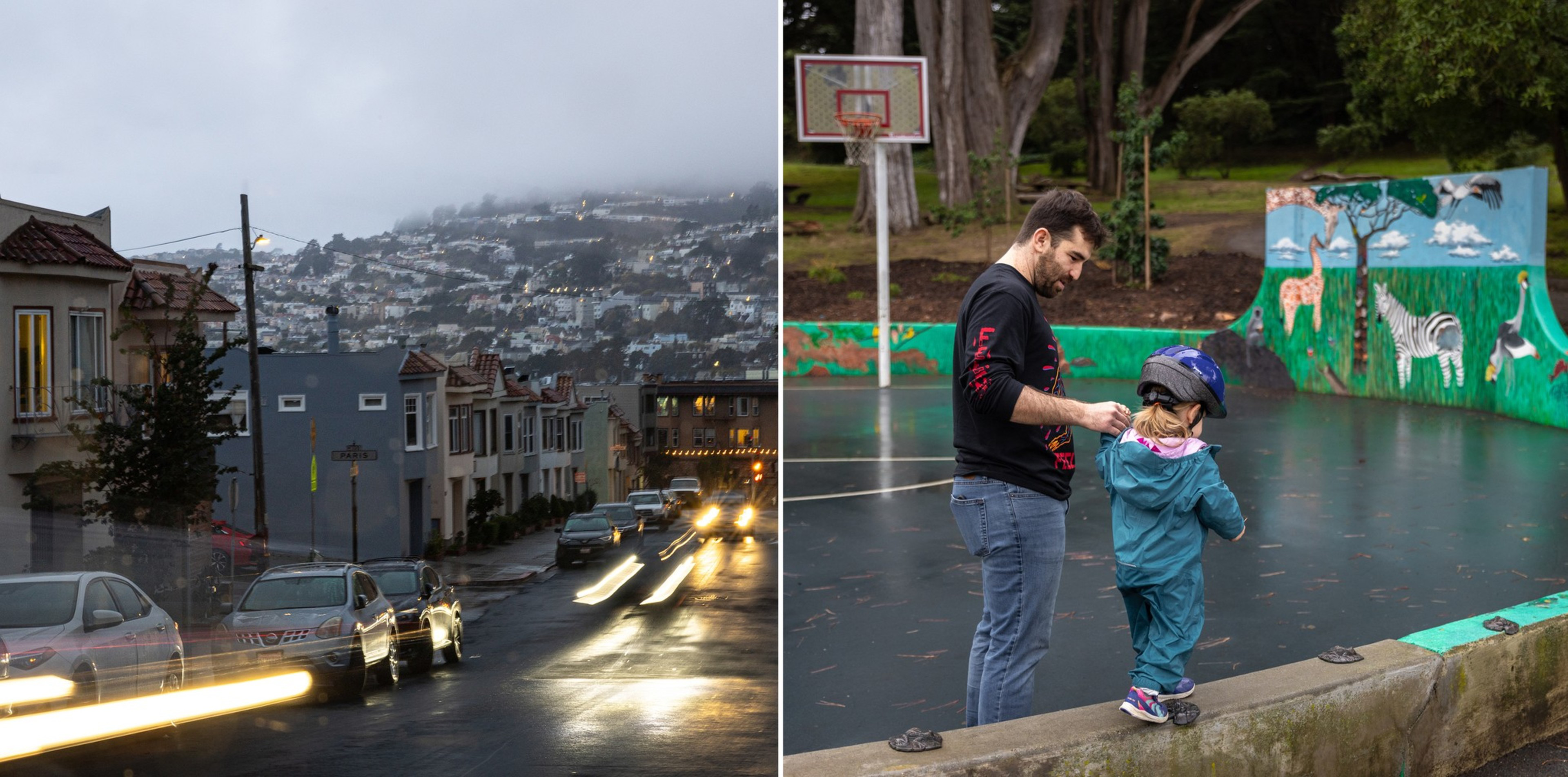Inside the Excelsior District’s Dark Horse Inn, a black-and-white movie—Monkey Business starring Cary Grant—casts a moody glow across the bar. The restaurant’s owner, Sean Ingram, jokes with a family pushing a stroller out the door that he’ll be over for grandma’s leftover Thanksgiving beef brisket. Diners sit two to a table down a row, immersed in deep conversations with lots of eye contact and without a cellphone in sight because they’re not busy posting food photos to Instagram.
It’s as if you’re in another world—and many San Franciscans see it that way.
Ingram’s partner in life and business, Andrea Ferrucci, leaned into the perception of the neighborhood as a remote part of San Francisco when she created a pub crawl guide. She labeled the Excelsior with a phrase befitting a 15th century atlas: “Here Be Dragons.”
There may not be dragons in the Excelsior, but Ferrucci and Ingram embraced the unknown when naming their Geneva Avenue bar and restaurant (opens in new tab)—the Dark Horse Inn—12 years ago. A “dark horse” might be an underdog, but it’s also the unexpected winner at the end of the race, and their business has since become an Excelsior institution, known for its delicious burgers and extensive craft cocktail list.

“The E,” one of San Francisco’s most populous but least appreciated neighborhoods in the southeast of the city abutting McLaren Park, is a vibrant and diverse community full of treasures hiding in plain sight: an International Style laundromat designed by renowned architect Mario Ciampi (opens in new tab), a not-Walgreens drugstore that’s been in business for over 70 years (opens in new tab), a Chinese restaurant famous for its Filipino food (opens in new tab), a deli that doubles (opens in new tab) as an alteration shop, a filming location from The Princess Diaries and a dizzying array of international street names. Where else can you stand at the intersection of Paris Street and France Avenue?

Globe-trotting streetscape notwithstanding, for too long, the Excelsior has been off the map—literally. The neighborhood’s name means “Ever Upward” in Latin, and one explanation for all those international street names is that the once-rural tract of the city was trying to rebrand itself as cosmopolitan. Yet despite such aspirations, its hinterland reputation has been steadfast.
“It’s as if the city ends at Glen Park,” said 20-year resident John Kealy, who’s seen one too many maps of San Francisco that don’t even bother to include the neighborhood.
New Wave, Old Roots
Tala Drzewiecki only opened her elegant-yet-informal wine bar Tala (opens in new tab) in June, but it’s already attracting a deep bench of regulars.
“I get thanked every single day for doing what I’m doing,” she said. “People tell me they feel like they’re transported to some part of Europe when they walk through the doors on Mission Street.”
The atmosphere may feel Parisian—crystal chandeliers and upholstered armchairs up front, a dahlia-filled mural inspired by the Palace Hotel’s Pied Piper above the bar—but the clientele is decidedly local.

Introductions at Tala often begin with the assurance that you’re a San Francisco or Bay Area native, though out-of-town oenophiles visiting from Connecticut were welcomed with just as much warmth by Drzewiecki, who is not a sommelier but a “wine educator” with 10 years experience.
When pouring a prié blanc—made with grapes from the highest elevation of any commercial vineyard in Europe—Drzewiecki pulled out a map to show the region’s exact location in Italy. Maybe because she has also seen city plans that don’t include her own neighborhood, she’s quick to point out geographical locations to her customers. It’s this kind of service and deep-yet-approachable wine knowledge that make Tala unique.
“She’s pouring stuff you don’t see anywhere else,” said customer Justin Caraway, another longtime Excelsior resident.
Yet Drzewiecki is all too familiar with encountering people who assume Excelsior’s irrelevance—people who tell her they never go to the neighborhood and don’t even consider it part of San Francisco.
“It’s insulting,” she said. “It undermines the importance of this historic neighborhood.”
The 1907 building in which Tala is located opened as a branch of the Bank of Italy—the nucleus of today’s multinational Bank of America—and a safe complete with pneumatic tubes still stands on the second floor. The longtime Italian community is represented by places like the Italian American Social Club (opens in new tab) and the Calabria Bros Deli (opens in new tab), where you can pick up Chinotto sodas and five types of biscotti.

Another newbie business that already feels like a classic is just across the street from Tala is The Korner Store Bites and Vibes (opens in new tab). The restaurant opened in February as a new incarnation of Ina Jungin Lee’s previous Korean restaurant on Valencia Street (opens in new tab), which was a secret cocktail bar inside what appeared to be only a Korean snack shop.
With no upstairs neighbors to complain about noise and a full return of the bar’s popular soju-drenched menu, Lee added the “Bites and Vibes” to reference the expanded menu and ability to dance freely in the expansive warehouse space.
While Lee doesn’t get as much foot traffic as she did in her Mission location, there are other, more intangible, benefits to the Korner Store’s new digs.
“Being here, I feel I’m cared for,” Lee said. “And, therefore, the entire community is cared for.”
The Queens of San Francisco
The interior of Little Joe’s Pizza has the atmosphere of a bordello mixed with a ski chalet: dark wood trim and wagon wheel chandeliers with velvet-embossed red wallpaper and glossy black vinyl booths. Niners gear is everywhere, in photos and memorabilia on the walls, on the television playing a replay of Sunday’s game on a Monday afternoon.
It’s the kind of place that exemplifies the Excelsior, which local John Kealy described as “the Queens of San Francisco.”
A working-class neighborhood that’s highly diverse—historically Italian and Irish but more recently Asian and Pacific Islander and Latino—the Excelsior has more families and multigenerational homes than many other San Francisco neighborhoods. It’s more blue-collar and less fancy, but that doesn’t mean it’s less special. You can have beignets and Cajun shrimp at the women-owned and New Orleans-inspired Gentilly (opens in new tab) or get your clothes altered (and designed) at the Filipino-owned Pioneer (opens in new tab), where tailor Genneth Rivera crafts barong tagalog (opens in new tab) from size small to 8X in the same business their dad began in the 1960s.

For these small businesses to thrive—everything from pupuserias to Hawaiian barbeque stands, taquerias to boba shops—many of them have relied on the Excelsior Action Group (opens in new tab) as well as a larger network of nonprofits supporting the community.
The group began 15 years ago, when community stakeholders in the Excelsior became concerned about a lack of investment. The group has since been connecting small business owners and up-and-coming entrepreneurs with resources, while working to illuminate Mission Street with string lights and create a new neon sign reading “Excelsior” for the neighborhood with money from the Civic Joy Fund, the same entity that’s been filling San Francisco with murals and live performances all year.
Neighborhood leaders are also restoring the massive neon sign of the former funeral home Valente, Marini, Perata and Company (opens in new tab), a sprawling mortuary serving the Italian community that was torn down to make way for a housing development.
“Lights have such an impact for the safety and vibrancy of our commercial corridor,” said Maribel Ramirez, Excelsior Action Group’s executive director.
Ramirez pointed to the high number of single-family homes in the area as something that makes the Excelsior stand apart from other San Francisco neighborhoods.
Excelsior residents are “invested in the city, because they have homeownership,” Ramirez said.
Yet the abundance of single-family homes also means there’s a lack of affordable housing for the working-class population that comprises so much of the neighborhood.
“There may be more homeowners here, but there are three generations packed in to afford it,” said Terry Vallen, executive director of the Filipino Community Center.

Ramirez called the Excelsior a “15-minute corridor,” meaning residents can accomplish their daily errands within a 15-minute walk. But that doesn’t mean it’s boring—strung along the main corridor of Mission Street along with the 14-Mission bus’s overhead wires are restaurants ranging from Cajun to Korean, delicious coffee, tattoo parlors, produce stores adorned by colorful murals and decades-old dry cleaners with hilarious owners.
“It’s diverse and welcoming in a city that’s seen a lot of flight and a lot of newcomers,” Ramirez said. Those longtime residents provide a reliable customer base that allows small businesses to succeed.
While the neighborhood used to have a large Italian and Irish population, demographics have shifted over the years to become more than 50% Asian, with a particularly large Filipino population.

The Filipino Community Center, founded in 2004 (opens in new tab) after hundreds of Filipino immigrants were laid off as airport screeners in the wake of 9/11, has been a lifeline for this population for 20 years.
A network of nonprofits—organizations like Coleman Advocates (opens in new tab), the Casa de Apoyo, Excelsior Works (opens in new tab) and Community Well (opens in new tab) among them—have spawned to address the challenges local residents face with language barriers, and housing, employment and economic insecurity.
In the Dark Horse Inn, there’s a shelf next to the bar with sundries for sale—everyday items like paper towels but also gourmet foodstuffs like Rancho Gordo beans, Bob’s Red Mill flours and Numi tea. It was a service the owners began during the pandemic to help out their customers. It was such a success that they decided to keep it going.

The shelf, in many ways, represents the Excelsior itself, a still-authentic neighborhood where people look out for one another. After all, they’re what keep Ingram and his restaurant going.
“All the families that come in once a week, that’s what has kept us alive,” he said.
